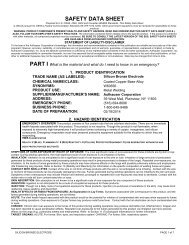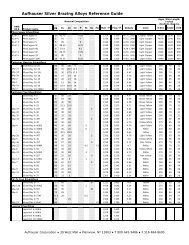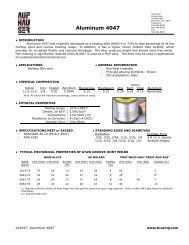MSDS - Aufhauser Corporation
MSDS - Aufhauser Corporation
MSDS - Aufhauser Corporation
You also want an ePaper? Increase the reach of your titles
YUMPU automatically turns print PDFs into web optimized ePapers that Google loves.
PART IV Is there any other useful information about this material?<br />
11. TOXICOLOGICAL INFORMATION<br />
TOXICITY DATA: Presented below are human toxicological data available for the components of these products present in concentration greater than<br />
1%. Other data for animals are available for the components of these products, but are not presented in this Safety Data Sheet.<br />
COPPER:<br />
IRON:<br />
TDLo (oral, human) = 120 g/kg;<br />
TDLo (oral, child) = 77 mg/kg; BAH,<br />
gastrointestinal tract effects<br />
gastrointestinal tract, blood effects<br />
SODIUM SILICATE:<br />
Skin irritancy (human) 250 mg/24 hours; severe<br />
SUSPECTED CANCER AGENT: The components of this product are listed as follows:<br />
COPPER: EPA-D (Not Classifiable as to Human Carcinogenicity)<br />
CRYOLITE (as a Fluoride Compound): ACGIH TLV-A4 (Not Classifiable as a Human Carcinogen); IARC-3 Unclassifiable as to<br />
Carcinogenicity in Humans)<br />
IRON OXIDE: IARC Group 3 ( Not Classifiable as to Carcinogenicity to Humans), ACGIH-TLV-A4 (Not Classifiable as a Human Carcinogen)<br />
SILICA SAND: IARC Group 3 ( Not Classifiable as to Carcinogenicity to Humans),<br />
The remaining components of this product are not found on the following lists: FEDERAL, OSHA Z LIST, NTP, and CAL/OSHA and therefore are not<br />
considered to be, nor suspected to be, cancer-causing agents by these agencies.<br />
IRRITANCY OF PRODUCT: Fumes generated by this product during welding may be irritating to contaminated skin, eyes and respiratory system.<br />
SENSITIZATION TO THE PRODUCT: Rare cases of allergic contact dermatitis have been reported in people working with copper dust.<br />
REPRODUCTIVE TOXICITY INFORMATION: Listed below is information concerning the effects of this product and its components on the human<br />
reproductive system.<br />
Mutagenicity: These components are not reported to produce mutagenic effects in humans. Animal mutation data are available for<br />
the Cryolite component of this product; these data were obtained during clinical studies on specific animal tissues exposed<br />
to high doses of this compound.<br />
Embryotoxicity: These components are not reported to produce embryotoxic effects in humans.<br />
Teratogenicity: These components are not reported to cause teratogenic effects in humans. Clinical studies on test animals<br />
exposed to relatively high doses of the Copper component of this product indicate teratogenic effects.<br />
Reproductive Toxicity: These components are not reported to cause reproductive effects in humans. Studies on test animals<br />
exposed to the Copper and Sodium Silicate component of this product indicate reproductive effects.<br />
A mutagen is a chemical, which causes permanent changes to genetic material (DNA) such that the changes will propagate<br />
through generational lines. An embryotoxin is a chemical, which causes damage to a developing embryo (i.e. within the first eight<br />
weeks of pregnancy in humans), but the damage does not propagate across generational lines. A teratogen is a chemical, which<br />
causes damage to a developing fetus, but the damage does not propagate across generational lines. A reproductive toxin is<br />
any substance, which interferes in any way with the reproductive process.<br />
BIOLOGICAL EXPOSURE INDICES: The following Biological Exposure Indices (BEIs) have been determined for components of this product are as<br />
follows:<br />
CHEMICAL DETERMINANT SAMPLING TIME BEI<br />
Fluorides in Urine<br />
Prior to Shift<br />
End of Shift<br />
3 mg/g creatinine<br />
10 mg/g creatinine<br />
12. ECOLOGICAL INFORMATION<br />
ALL WORK PRACTICES MUST BE AIMED AT ELIMINATING ENVIRONMENTAL CONTAMINATION.<br />
ENVIRONMENTAL STABILITY: The components of this product are expected to persist in the environment for an extended period of time. The<br />
components of this product will react with water and air to form a variety of metal oxide compounds. The following environmental data are available for<br />
the components of this product.<br />
COPPER: Solubility: Insoluble. There is no evidence of any biotransformation for copper compounds. Copper is accumulated by all plants and<br />
animals. BCF Algae = 12; plants = 1,000; invertebrate = 1,000, fish = 667 and fish = 200 (Soluble copper salts).<br />
EFFECT OF MATERIAL ON PLANTS or ANIMALS: Animal studies on copper, and silicon, indicate various health effects after ingestion and<br />
exposures. Specific data on test animals are available, but are not presented in this Safety Data Sheet .<br />
EFFECT OF CHEMICAL ON AQUATIC LIFE: This product may cause adverse effects on aquatic life, especially if large quantities are released into<br />
bodies of water. Low chronic aquatic limits indicate a high chronic hazard for the metals of this product, that may be concentrated to toxic levels in food<br />
chain. The following aquatic toxicity data are available for the components:<br />
COPPER:<br />
LC50 (fathead minnows) = 0.14 ppm in hard water<br />
LC50 (bluegill) = 0.02 ppm in soft water<br />
LC50 (brook trout) = 0.09 ppm in soft water<br />
13. DISPOSAL CONSIDERATIONS<br />
PREPARING WASTES FOR DISPOSAL: Waste disposal must be in accordance with appropriate Federal, State, and local regulations. This product, if<br />
unaltered by use, may be disposed of by treatment at a permitted facility or as advised by your local hazardous waste regulatory authority.<br />
EPA WASTE NUMBER: Not applicable to wastes consisting only of this product.<br />
ALUMINUM BRONZE ELECTRODE PAGE 5 of 8






